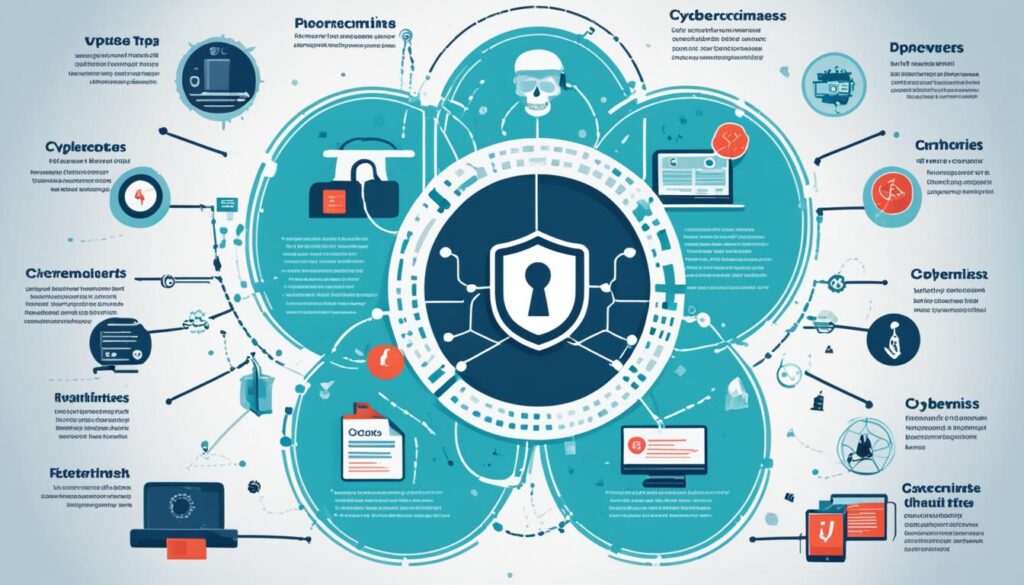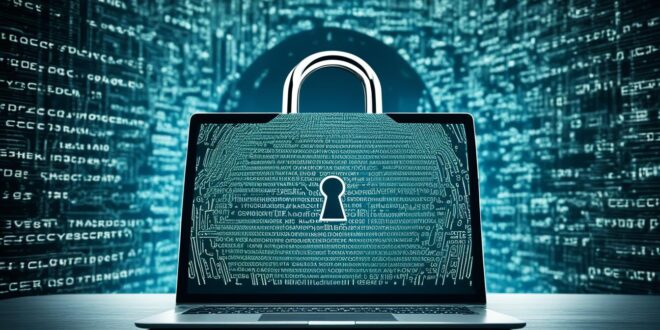“Cybersecurity is no longer just an IT issue, it’s a business issue.” – Ginni Rometty, former CEO of IBM
Our lives are deeply connected to the digital world now. This means we must protect our online presence more than ever. Cybersecurity is now a key part of our daily lives. It helps keep our data, devices, and online activities safe.
This guide will cover the basics of cybersecurity, the changing threats we face, and how to stay safe online. We aim to make you a smart digital user. By the end, you’ll know how to protect your online world.
Key Takeaways
- Cybersecurity is essential in the digital age to protect our personal and professional information.
- Cyber threats, such as malware, phishing, and data breaches, are constantly evolving, requiring vigilance and proactive measures.
- Implementing strong passwords, regular software updates, and multi-factor authentication are crucial cybersecurity practices.
- Understanding the importance of securing our devices, networks, and online accounts is key to maintaining digital safety.
- Cybersecurity is not just an IT concern, but a critical business and personal responsibility in the modern world.
What is Cybersecurity?
Cybersecurity protects digital systems, networks, and data from unauthorized access or harm. It’s not just about setting up barriers. It’s a complex mix of steps to prevent, detect, and respond to threats. At its core, cybersecurity focuses on keeping data confidential, integrity, and availability safe.
When you send an email, make online payments, or watch videos online, you’re using cybersecurity to stay safe.
Defining Cybersecurity
Today, our lives are deeply connected to the digital world. From smart home devices to health monitors, we’re all online. This connection means we must protect our cyber lives. Cybersecurity keeps our personal info safe, secures business data, and supports trust in our societies and economies.
The Importance of Cybersecurity
Ignoring cybersecurity can lead to big problems, like exposing patient records or disrupting national defense. It’s key for personal data protection, business data security, and national security implications. With our growing digital reliance, strong cybersecurity concepts and cybersecurity principles are more important than ever.

“Cybercrime might cost the world economy USD 10.5 trillion per year by 2025.”
Types of Cyber Threats
In today’s digital world, cybercriminals use many harmful tools. They use malware to get into systems and phishing scams to trick people. These threats can really hurt both people and companies.
Malware: The Digital Infection
Malware is a broad term for harmful software. It includes viruses, worms, and trojans. These can mess with files, watch what you do, or let others into your system. They’re like the common cold of the digital world – everywhere, annoying, and can cause harm.
Phishing and Social Engineering: Deceiving the Unsuspecting
Have you ever gotten an email from a “prince” offering you a lot of money? Or a message from your “bank” asking for your account info? Those are phishing tries – trying to get you to share private info or let others into your stuff. Spear-phishing is a sneaky version that targets certain people. Social engineering uses tricks to get people to give up access or data.
DDoS and Data Breaches: Disruption and Theft
DDoS attacks send so much traffic to a site that it crashes. It’s like a digital traffic jam, but with bad intentions. Data breaches are when someone gets into a system and steals private info. This info can be personal stuff, money details, secrets, or important business info. This can cause big problems for those affected.
Knowing about different cyber threats helps us protect our online world. By being careful and using strong security, we can keep our online stuff safe from cybercriminals.

“Cybersecurity is no longer just an IT issue, it’s a business issue. The threats are real, and the consequences can be devastating.”
Challenges of Cybersecurity
Protecting our digital world from cyber threats is tough. Cybersecurity experts face many challenges that need constant attention and quick thinking. We deal with fast-changing malware, human mistakes, and insider threats, making the field very complex.
One big challenge is the fast pace of technology changes. Cybercriminals use new weaknesses quickly, pushing us to always be ahead. Recent stats show that about 170 out of nearly 400 suggestions to improve the National Cybersecurity Strategy were ignored by May. This shows how hard it is to keep up with cyber threats.
The complexity of modern networks adds to the problem. With more devices connected and cloud computing, the risk area has grown a lot. Over 800 suggestions were made to boost federal cybersecurity, but 221 were not done by May. Protecting these complex networks needs a detailed plan and constant watch.
Also, cyber threats come from all over the world. This makes it hard to set clear rules and plan responses. Ransomware attacks on key sectors like health care have caused big financial losses, with one attack on Change Healthcare costing nearly $874 million. We need to work together across borders to fight these global threats.
The challenges in cybersecurity are many and always changing. We face issues like human mistakes and complex networks. To stay ahead, we must be quick, flexible, and dedicated to learning, working together, and innovating. By doing this, we can strengthen our defenses and keep our digital world safe from cyber threats.
“Cybersecurity is not a one-time fix, but a continuous process of adaptation and improvement.”
Cybersecurity Best Practices
Staying safe online means being proactive. Using strong cybersecurity steps is key to protecting your data and info. Here are some top tips to strengthen your online security.
Strong Passwords and Multi-Factor Authentication
Start by picking strong, unique passwords. Tools like password managers help keep these safe. Adding multi-factor authentication or two-factor authentication means you need more than just a password to get in.
Software Updates and Backups
It’s vital to keep your software updated. These updates often fix security issues. Back up your data in different places to protect it from loss or theft. Make sure your backups are safe and tested.
Secure Networks and Account Monitoring
Don’t share sensitive info on public Wi-Fi because it’s not safe. Use a Virtual Private Network (VPN) to hide your online activities. Check your account activity often for anything odd to catch cyber threats early.
Following these steps can greatly improve your password management, software updates, and network security. This helps keep your digital life safe from many cyber threats.
Cybersecurity for Businesses
In today’s fast-paced business world, keeping data safe is key. A data breach can lead to big problems, like leaked secrets and lost customer trust. It’s vital to follow data protection and privacy regulations to avoid big fines and legal trouble.
Cyberattacks, like DDoS attacks, can knock out important systems and services. This can cause businesses to lose money and upset customers. A data breach can also hurt a company’s reputation and make customers leave. It’s important to keep an eye on the security of your supply chain too, as problems there can spread to others.
Data Protection and Compliance
Protecting data and following the law is a must for businesses. It’s important to stick to rules like GDPR and HIPAA. Not doing so can lead to big fines and harm your reputation.
Operational Continuity and Reputation
Keeping your business running smoothly despite cyber threats is crucial. Having good data backup and disaster recovery plans helps you bounce back fast from disruptions. A strong cybersecurity approach also keeps your reputation and brand safe, keeping customers trusting and loyal.
“Every business that uses the Internet is responsible for creating a culture of security.”
Securing Your Digital Life
Staying safe online means being careful, smart, and proactive. We need to be aware of risks and take steps to protect ourselves. This includes being cautious with links and emails, keeping software updated, and using extra security checks when we can.
Personal Cybersecurity Habits
Being careful online is key to keeping our digital life safe. We should watch out for phishing scams that try to trick us into giving away sensitive info. It’s also important to use strong, unique passwords for all accounts. And, turning on two-factor authentication (2FA) adds an extra layer of protection against hackers.
Safeguarding Devices and Networks
Protecting our devices and networks is just as important as our online habits. We should lock our devices when not in use and avoid public Wi-Fi networks. It’s also wise to be careful with USB drives from unknown sources, as they might have harmful software. Keeping our software updated and backing up our data regularly can also shield us from threats and data loss.
 Gmrxe Entertainment and Information
Gmrxe Entertainment and Information





i dont like that article
why, I think it’s informative